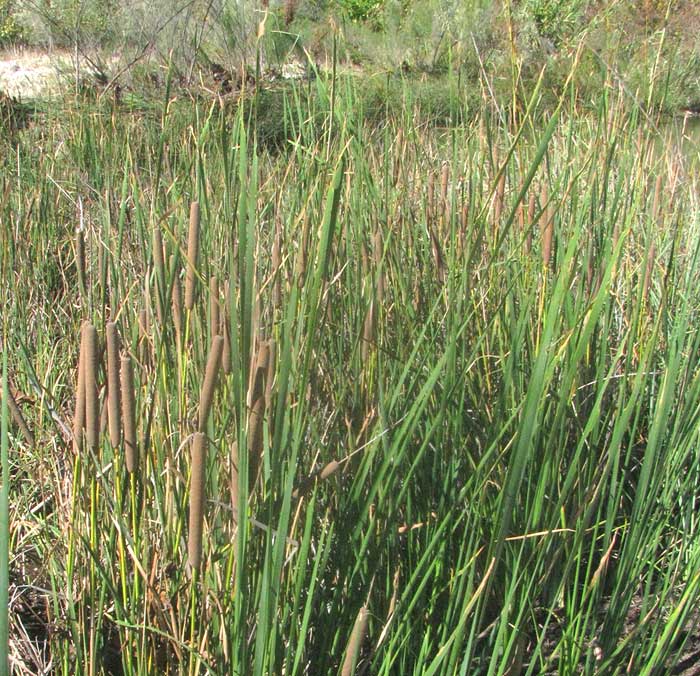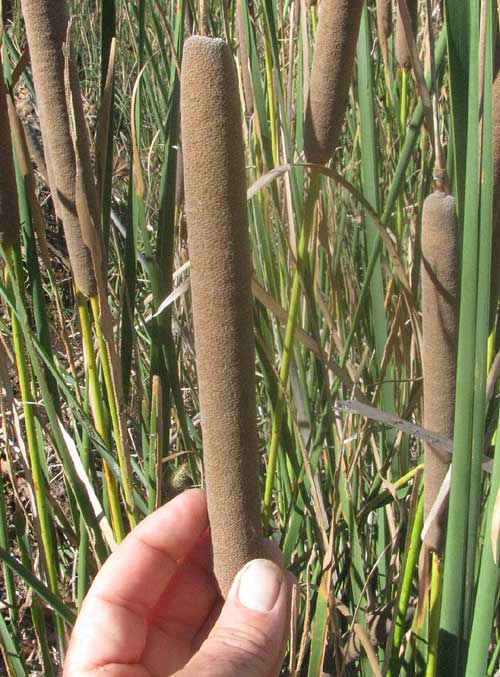Excerpts from Jim Conrad's
Naturalist Newsletter

from the October 27, 2013 Newsletter issued from the Frio Canyon Nature Education Center in the valley of the Dry Frio River in northern Uvalde County, southwestern Texas, on the southern border of the Edwards Plateau; elevation ~1750m (~5750 ft); N29.62°, W99.86°; USA
SOUTHERN CATTAIL
Near the Giant Reeds a thicket of cattails grew along the water's edge. They weren't the same kind of cattail I've commonly seen back in Kentucky and Mississippi, though, commonly called the Common or Broadleaf Cattail; these cattails were smaller, with narrower leaves and smaller, spike-type heads. A small part of the colony is shown above.
To provide an idea of the spikes' size -- about finger thick -- you can see a mature head held in my hand below:

This smaller species is the Southern Cattail, TYPHA DOMINGENSIS, in the US native throughout the southwestern states and along the eastern Gulf coast, as well as throughout temperate and tropical regions worldwide -- basically between 40º north and south latitude. Being so widely distributed and known to be capable of aggressively invading certain wetland habitats, including disturbed ones, I'm surprised I've seen it so rarely in the eastern US, except along the Gulf coast.
Our pictures show that atop the brown, frankfurter-like head a slender, needle-like rachis continues upward, as if the frankfurter were skewered. The top needle previously bore hundreds of tiny male flowers. The brown frankfurter is composed of multitudinous female flowers with ovaries developing into fruits. The spikes' brownness is produced by the brown tops of closely packed female flowers.
Everyone knows you can eat starchy cattail rhizomes, raw or cooked, though ones I've dug never were as thick and succulent as the books show. Beaver, deer, muskrats and the like relish them, however. Medicinally, the leaves and rhizomes are considered to be diuretic (make you pee), plus when the male flowers are producing pollen, the pollen can be used to staunch bleeding, which can be said of many dry powders.
Cattail stems and leaves make decent thatch and can be used for making paper, and can be woven into mats, chairs, hats, etc. Cattails grow so fast that they're a good source of biomass for the compost heap or as a source of fuel. Mature fruits bear hairs enabling the fruits to parachute into the wind, so fluffy masses of fruits can be used for stuffing pillows and the like. Cattail fluff provides good insulation and buoyancy, until it gets wet. Cattails' extensive root system helps stabilize river banks and shores.
Cattail's are not grasses or sedges, but rather are such distinct organisms that they have their own family, the Cattail Family, the Typhaceae, on the phylogenetic Tree of Life residing not far from the mostly tropical Bromeliad or Air-plant Family, the Bromeliaceae, of all things.